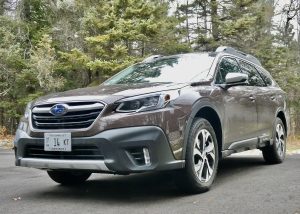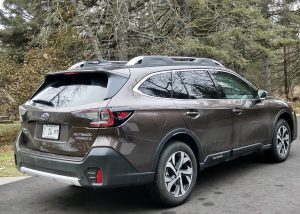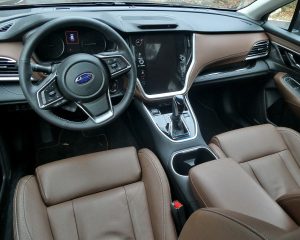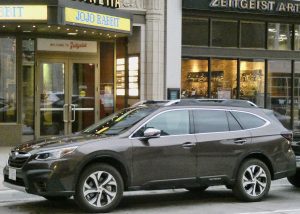Whether SUV or station wagon, Subaru Outback fits

New Outback on new platform has flat-opposed 2.4 Turbo 4 with 260 horsepower and 277 foot-pounds of torque.
By John Gilbert
There is practically no resemblance between the 2020 Subaru Outback and any Subaru you might have owned, ridden in or observed from 15 or 20 years ago. That is not entirely a bad thing, because the newest Subarus have blazed quite a trail for themselves as being among the most trusted and depended-upon cars in creation. and they’ve earned every degree of loyalty they’ve accumulated.
Subaru has fought its way to automotive prominence over the last four decaded, spending quite a few of those years being known for building all-wheel-drive vehicles as tough as its parent — Fuji Heavy Industries, in Japan. Whenever that was acknowledged, it was mainly uttered in scorn, because as rugged and tough as its cars were, many Subaru models didn’t have a lot more style or agility than those big earth-moving road graders made back in Japan.
But they were tough, and established a loyal clientele, especially in the Upper Midwest. There must be a very profitable Subaru dealership on Michigan’s Upper Peninsula, because when you drive to Houghton or Marquette for a hockey series, you see Subarus all over the place. Ten-foot-deep snowdrifts are not intimidating to Subaru owners.
The same is true in Duluth, Minnesota, where winter driving is a ferocious accompaniment to winter driving. In recent years, so many competing cars have added all-wheel drive that Subaru’s once vital advantage is no more. But the loyalty remains.
Since the surge over the last decade to SUVs, Subaru has been reaching for the ring to get on the merry-go-round, and it has gone so far as to complain that it never gets credit for inventing the first SUVs. I always thought that was misdirected, because a clever ad agency could have come up with dozens of ways to point out that Subaru made SUVs before there was such a thing as SUVs.
Over the years, also, Subarus have become more and more refined, and when I drove a new Legacy sedan a few years ago, I said it doesn’t look like any previous Subaru — and that was a good thing! Over the last five years, Subarus have added style and appearance queues to make their sedans and compact wagons much more appealing, while sticking stubbornly to those little flat-opposed engines, wherein the cylinders go back and forth instead of up and down, with the crankshaft in the middle, and the cylinders oppose each other, taking the design from vintage Porsches.
Adding things like overhead camshafts and fuel injection have helped Subaru gain stature, and the advent of the Impreza, and then its offshoots, the WRX and then the WRX STI high-performance models, which became the favorite tool of serious off-road racers. If you haven’t driven a fully-loaded WRX STI, you ought to, because they show what can be done if you take a winter-beating, tough compact and arm it with stiff suspension, Recaro bucket seats, and more power than ever should have been put into a little car.
There are still a number of compacts and midsize Subaru sedans out there with their asymmetric all-wheel drive to go anywhere at any time of the year. And Subaru has maintained its course, aimed at the popularity of SUVs.
That brings us back around to the Outback, which began life as a neat compact station wagon version of a Subaru sedan, but it has grown into its own image now. The newest Outback is still a station wagon, but it is bigger — longer, wider, heavier and roomier than its predecessors, and with that AWD and choice of engines, you can take the family anywhere in some degree of style and comfort.
As someone who has test-driven Subarus for several decades, as its personalities have changed and then changed again, I have had one issue that always bothered me. No Subaru model ever seemed to get the fuel economy its sticker sheet indicated. It wasn’t until three or four years ago that I realized that if you drive under the speed limit — say 63 in a 65, or 53 in a 55 — you can reach those lofty figures and get an honest 30 miles per gallon in a midsize sedan or compact. But if you try to keep up with the flow on freeways these days, which means going 5 mph or so over the limits, you might calculate that you’re at the low to mid 20s, instead of 30.
My belief is that Subaru knows it’s all a compromise, and every time it had the choice, its engineers went for more power — impressively, except to those oddball reviewers who like higher mpg. A co-worker I used to have was considering two alternative cars, and one was a Subaru. I alerted her to my concerns, saying nothing but good things about the Subaru, except for the fuel economy. Despite my warnings, she bought the Subaru. Several months later I asked her how she liked it, and she said she liked everything about it — except it got lousy fuel economy. She acted like it was my fault.
The new Outback for 2020 still has the flat-opposed “Boxer” engine, now up to 2.4 liters, and it is turbocharged to deliver 260 horsepower at 5,600 RPMs, with 277 foot-pounds of torque, occurring between 2,000 and 4,800 RPMs. Certainly enough to move the 3,937-pound wagon swiftly. I must apologize, because my avid following of the history of such cars prevents me from thinking of the Outback as an SUV, even though Subaru is eager to earn that current and trendy monicker instead of the outdated and stodgy-sounding “station wagon.”
The Touring XT model, which the test drive vehicle was, had a continuously variable transmission, which shifts by bands and has a somewhat droning feel as it glides up to its next ratio. The test Outback also will tow a 3,500-pound trailer, which is impressive for such a compact vehicle.
Inside, the Outback is comfortable and has all the features of contemporary midsize SUVs, along with enough height for ground clearance into your snow-filled driveway or your cabin where you haul your snowmobile in the winter or fishing boat in the summer.
Included among those features are stop-start at red lights to improve fuel economy, EyeSight advanced adaptive cruise control, lane centering to keep you in your lane on the highway, Starlink Multimedia navigation with an 11.6-inch touchscreen that controls audio, climate and Bluetooth connectivity. Blind-spot detection and lane-change assist complement the power seat adjustments and a supple but slightly squishy suspension and the CVT transmission to keep the high-powered engine under conservative control. Active torque-vectoring keeps you headed the right direction around corners, and the climate controlled interior and your bucket seat settings keeps the Outback a pleasant place to be.
Adaptive headlights, taillights and running lights are all LEDs for maximum brightness, and with all its assets the Outback will be the latest in a move up the contemporary ladder for the loyalty customers who know and depend on what Subarus offer. Fuel mileage on the turbo model range from 23 city to 30 highway, although we found it wasn’t real willing to reach over 25 mpg, but it was already chilly outside for the impending winter.
The Outback Touring XT model, with sunroof and Nappa leather seats among its long list of features, reached and just barely cleared $40,000 — $40,705 to be exact, including destination. Subaru wants the Outback to be known more as an SUV than a station wagon, and while I don’t find anything objectionable about the term station wagon, I hope it isn’t because Subaru realizes it can charge more for a vehicle if it’s considered an SUV.





 John Gilbert is a lifetime Minnesotan and career journalist, specializing in cars and sports during and since spending 30 years at the Minneapolis Tribune, now the Star Tribune. More recently, he has continued translating the high-tech world of autos and sharing his passionate insights as a freelance writer/photographer/broadcaster. A member of the prestigious North American Car and Truck of the Year jury since 1993. John can be heard Monday-Friday from 9-11am on 610 KDAL(www.kdal610.com) on the "John Gilbert Show," and writes a column in the Duluth Reader.
John Gilbert is a lifetime Minnesotan and career journalist, specializing in cars and sports during and since spending 30 years at the Minneapolis Tribune, now the Star Tribune. More recently, he has continued translating the high-tech world of autos and sharing his passionate insights as a freelance writer/photographer/broadcaster. A member of the prestigious North American Car and Truck of the Year jury since 1993. John can be heard Monday-Friday from 9-11am on 610 KDAL(www.kdal610.com) on the "John Gilbert Show," and writes a column in the Duluth Reader.